Search Results
BART invites public to celebrate life of Dr. Martin Luther King Jr. on Jan. 15
On Tuesday, January 15 from noon to 1:30 pm, BART invites the public to celebrate the life of Dr. Martin Luther King Jr. This year’s event will also commemorate the 50th anniversary of the 1963 March on Washington through song, spoken word and a multimedia presentation depicting significant scenes that led to
Disability Pride Month: Harold Willson's fight to make BART accessible for all
Last week, Governor Gavin Newsom proclaimed July as Disability Pride Month. The month marks the anniversary of the Americans with Disabilities Act (ADA) that was signed into law on July 26, 1990. The ADA was a major milestone for civil rights in the U.S. that "prohibits discrimination against individuals with disabilities in all areas of public life, removing barriers to employment, transportation, public services and other critical areas," per Newsom's proclamation.
More than 7% of BART riders have a disability, and BART is continuously working to make the system as easy to use as possible for every single person who rides and relies on us. Our work is ongoing.
This month, BART will be celebrating riders with disabilities and the contributions they have made to our transportation system and region.
We begin with the story of Harold Willson, originally published in 2022.
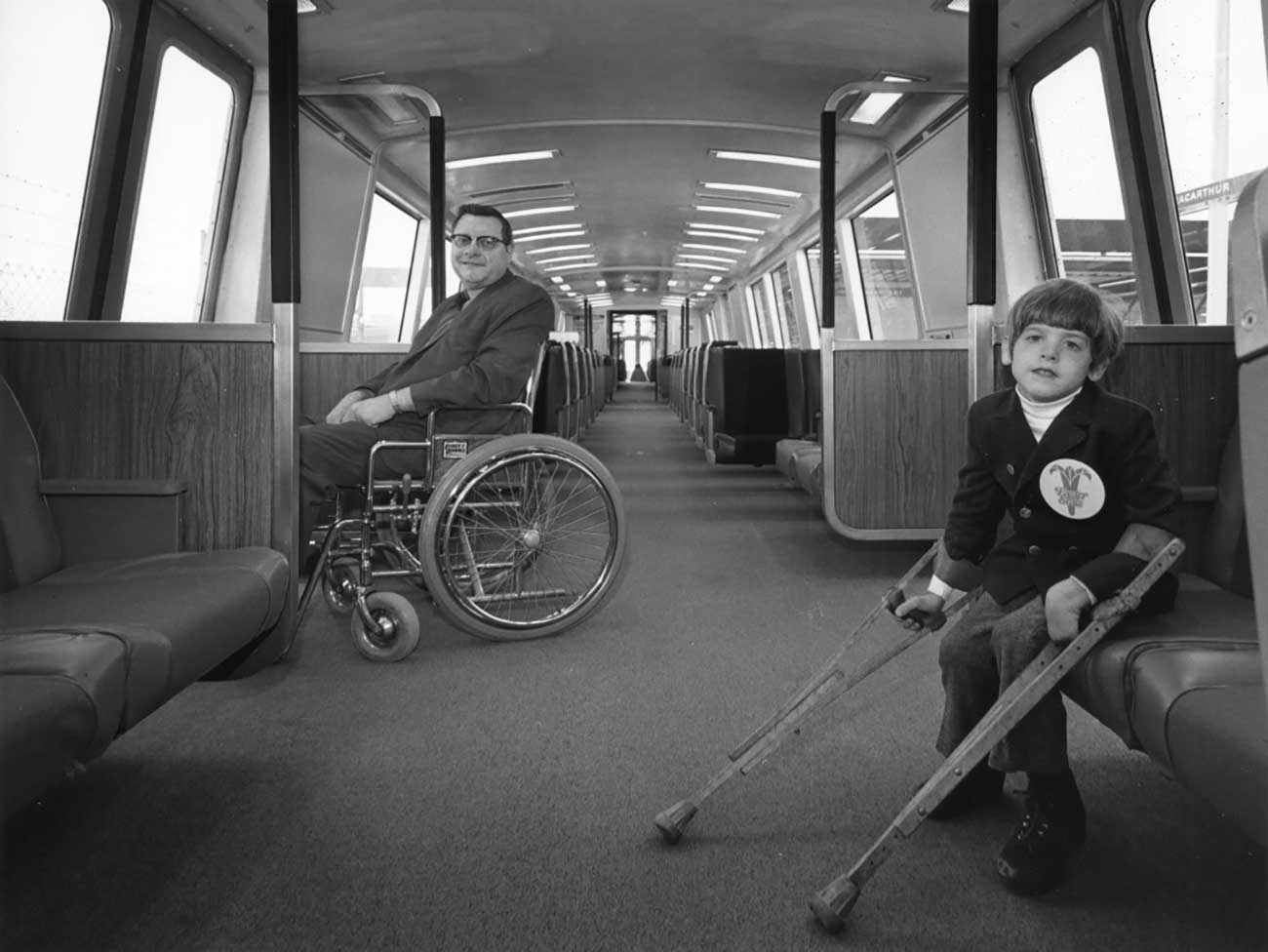
Harold Willson (left) smiles at Eric Staley (right) on a BART train in 1972. Photo courtesy of Kaiser Permanente Heritage Resources.
“There is a special personal pride in being the first handicapped person in a wheelchair to use a subway train, and to represent all handicapped travelers who will use the BART system in years to come. I’ll never forget that sense of freedom I experienced as I boarded the BART train.”
– Harold Willson, quoted in “Accent on Living,” Spring 1973
When Harold Willson was 21 years old, his life forever changed.
The West Virginia native dropped out of university when his funds ran out and started working as a coal miner. On a regular day in February 1948, about two years after he began working in the mines, Willson was caught in a slate fall. He suffered severe spinal damage, broken ribs, and a broken back.
Willson’s tragic accident spurred a lifetime of advocacy. His work to raise awareness and secure rights and access continues to impact the freedom and mobility of transit riders across the nation. Thanks to Willson’s efforts in the 1960s, BART became the first public transit system in the nation with accessible trains and stations.
“Never again would skeptics be able to argue that trains could not be made wheelchair accessible" after Willson, write Doriz Zames Fleischer and Frieda Zames in “The Disability Rights Movement."
Four months after his accident, Willson was transferred by train to the Kaiser Foundation Rehabilitation Center in Vallejo. It was a felicitous move, one that would forever alter the course of his life and public transportation. In his two years at the facility, Willson underwent intensive physical therapy and multiple surgeries. Doctors told the young man he would use a wheelchair for the rest of his life.
In 1950, Willson joined Bank of America and married Patricia Leister, who was a member of the nursing staff that treated him at Kaiser. Six years later, he completed a degree in business administration at Golden Gate College, and a year after that, he was hired as an accountant at the Kaiser Foundation Medical Care Program. Willson would go on to hold a variety of positions at Kaiser throughout his life. He’d retire as a senior financial analyst for the Kaiser Foundation Health Plan in 1977.
Said Cuong Le, historian for the nonprofit health care provider: "Kaiser Permanente is fortunate to have passionate and influential employees like Harold Willson, whose remarkable success advocating for historically overlooked needs of people with disabilities led to substantially improved conditions."
During the years that Willson lived in the Bay Area, the region was aflutter with the news of a soon-to-be-constructed rapid transit system that would connect the Bay. The tenor of excitement shifted for Willson when he learned the system, to be called the San Francisco Bay Area Rapid Transit District, or BART for short, would not be accessible for people with disabilities. Four percent of the Bay Area population at the time had severely limited mobility, meaning the BART system would exclude them from its ridership.
“When the system was built in the 60s, the elevators weren’t a consideration,” said Bob Franklin, BART’s Director of Customer Access and Accessibility. “They were completely an afterthought.”

Photo courtesy of Kaiser Permanente Heritage Resources.
Willson reached out to BART and offered his services as a “volunteer consultant” to the BART Board starting in 1964. He had a unique and compassionate approach to advocacy, according to the people who knew and worked with him.
“His suggestion was novel for rapid transit, no one had tried it,” A.E. Wolf, the General Superintendent of Transportation for BART, is quoted as saying in the Spring 1973 issue of “Accent on Living." “It posed all kinds of problems; cost was significant. Our staff, including myself, was hardly enthusiastic.”
“But, he did not threaten, nor picket, nor sulk, nor lose patience,” Wolf continued. “Instead, he was professional, pleasant, firm and persistent. As a result, he won the support of each of our board members while maintaining a friendly relationship with our staff.”
Willson’s approach was to “sell” the idea for an accessible BART system by contacting people one by one and having individual conversations with them, slowly winning them over to his cause.
“You could be a pioneer in being the first major public transportation system to be accessible to the handicapped,” Willson told the BART Board and staff in 1963, according to Michael Healy’s “BART: The Dramatic History of the Bay Area Rapid Transit System.”
Willson’s methods worked. In 1968, the BART Board requested $7 million from the California legislature to include accessible elevators in its plans (the figure was later revised to $10 million).
Willson’s advocacy did not stop there. He and representatives from BART continued to lobby Sacramento until $150 million in additional funding for wheelchair accessibility was allocated to the under-construction system in March 1969. BART, with Willson's guidance and persistence, was ahead of its time. It would be more than two decades later that the Americans with Disabilities Act (ADA) was signed into law.
Among the accommodations the funding secured were elevators at every station, telephones in elevators and stations that were accessible for wheelchair users, special service gates and handrails, Braille symbols on elevator door casings, loudspeaker directions for those who are low vision and blind, closed-circuit televisions as needed, and level boarding between the platform and train.
In the years since Willson’s advocacy, BART has added even more accessible features to the system, which you can read about on bart.gov/guide/accessibility.
After BART was built, Willson would go on to continue advocating for accessibility. In 1971, Willson and Wilmot R. McCutchen, Chief of Design for BART, testified before a special U.S. Senate Committee on Aging. Their testimony was “an important precursor to raising public consciousness of the issue of disabled access,” writes Healy in his "BART" book. A robust disability rights and independent living movement would emerge in the years that followed Willson's lobbying.

Image courtesy of Kaiser Permanente Heritage Resources.
Willson died in the Bay Area in 1994.
His legacy continues to reverberate across the nation. After BART, the newly built transit systems WMATA and MARTA also made their systems accessible, setting a new precedent for future generations of public transit.
“All of this is possible because one man had a bright shiny dream, and he made it come true,” Wolf is quoted as saying in a 2008 journal.
Denise Figueroa, the Executive Director of the Independent Living Center of the Hudson Valley and a longtime transit advocate, noted that transit has “come a very long way in terms of accessibility” from the 1950s and 1960s.
“In those days, when Willson first started out, there wasn’t an expectation of accessibility,” she said by phone. “Over the years, what has changed is that the public expects transit to be accessible – even non-disabled people.”
Figueroa said the mentality of transit systems was often, “It’s not my problem.” She said agencies would routinely cite cost as the prohibiting factor.
“The argument was always: It’s too expensive,” she said. That changed with the passage of ADA (1990), as well as Section 504 of the Rehabilitation Act (1973), which requires public entities that receive federal funding to ensure that people with disabilities are not discriminated against, nor denied goods or services.
Today, BART continues to bolster its efforts to make the system accessible for all riders. The transit agency hosts a monthly BART Accessibility Task Force on the fourth Thursday of each month, where the public can voice concerns, ask questions, and provide input. BART, which is ADA accessible by law, also encourages passengers to make a Reasonable Modification Request if their needs are not being met.
When transit systems are accessible for all, said Franklin in closing, everybody wins.
“It’s a federal law now that we’re accessible to everyone,” he said. “And when we design it that way, everyone benefits. The more universally we can design something, the better it will be.”
The BART Accessibility Task Force (BATF) is actively recruiting new members. If you are interested or have questions, please contact, Elena Van Loo, Customer Access and Accessibility Department, by phone at (510) 874-7366 or by e-mail at [email protected].
BART PD’s Progressive Policing Bureau wins prestigious national award for innovation
The BART Police Department’s Progressive Policing and Community Engagement Bureau has won the American Public Transportation Association’s national Innovation Award. The Progressive Policing and Community Engagement Bureau (PPCEB) has established itself as a national model by increasing BART’s safety presence while ensuring the system is welcoming to all members of the community. The PPCEB is a trail blazing part of the effort to ensure BART is the safest way to travel across the Bay Area.
“The members of the Progressive Policing and Community Engagement Bureau are force multipliers for rider safety,” said BART PD interim Chief Kevin Franklin. “The bureau has become a national model with both transit and traditional law enforcement agencies reaching out to us to learn more about the innovative steps we’re taking to boost safety for our riders.”
The numbers show how the PPCEB is boosting rider safety. In the first six months of this year members of the PPCEB performed more than 10,700 welfare checks on people in the BART system who appeared to need help. There were more than 2,500 instances when PPCEB members intervened when they saw violations of BART’s Code of Conduct. In the past those violations would have required a response by a sworn officer. Instead, members of the PPCEB can offer a more appropriate response with unarmed, specially trained BART PD staff. That has freed up sworn officers to respond more quickly to urgent emergency calls. BART PD has one of the fastest response times for tier 1 emergency calls at an average of just more than 4 minutes.
The PPCEB is primarily composed of non-sworn Transit Ambassadors and Crisis Intervention Specialists. These unarmed employees of BART PD receive specialized training in de-escalation techniques. Transit Ambassadors walk dozens of trains and platforms each day. They’re equipped with radios to report safety concerns. They observe, report, and call upon traditional sworn officers when enforcement is needed. Crisis Intervention Specialists have backgrounds in social work and specialize in connecting people at risk with potentially lifesaving services.
The PPCEB was launched in 2020. It was the first of its kind for a transit agency in the U.S. The BART PD model stands out because members of the PPCEB are full-time BART PD employees as opposed to contractors that many other systems rely on. The bureau builds on a history of more than a decade of reform efforts aimed at elevating equitable policing at BART.
BART will begin to size trains for safety and efficiency starting September 11, 2023
When BART’s reimagined schedule launches September 11, 2023, BART will begin to shorten the length of its least crowded trains to improve safety, allow for a cleaner fleet of cars, and maximize BART’s scarce resources. The adjustment of train lengths is consistent with our top priority of ensuring BART is the safest way to travel around the Bay Area.
Shorter trains mean:
• More police and safety staff presence
• Cleaner trains
• Only new trains will be in service unless there is a need to run an old train
• Fewer delays because new cars have double the reliability rate of old cars and we will have more standby trains available
• $12 million is cost savings
BART will still run long trains during special events.
While BART plans to run shorter trains, we will remain very nimble and monitor crowded data on an hourly basis. Our commitment is to quickly add additional cars to trains if there is a high level of crowding, especially during peak commute hours. While we plan to launch this effort using 8-car and 6-car trains, we will quickly adjust as ridership grows.
Running trains with fewer cars will allow the BART Police Department to increase its visibility on trains and platforms while using the same number of staff. When there’s a call for service, officers can clear shorter trains much more quickly. Officers on train patrols will also be able to walk more of the in-service train cars.
“There is safety in numbers and that’s especially true on BART,” said BART PD interim Chief Kevin Franklin. “This change will allow us to have more eyes on train car as we continue to boost our visible safety presence with our officers and unarmed Transit Ambassadors and Crisis Intervention Specialists. A lot of unwanted behavior will be deterred through the presence of more riders and potential witnesses in every train car.”
Shortening trains allows BART to run only Fleet of the Future trains for its base schedule. Legacy trains will still be used if they are needed during large events or if they are needed to replace a new train, but this move accelerates the retirement of the old fleet.
Sizing trains for safety is a direct response to feedback gathered through the Not One More Girl anti-harassment initiative. Eliminating empty and near-empty trains cars will create a safer, more welcoming environment for women, girls, gender non-conforming people, seniors, families, and all riders. BART encourages people concerned about safety to ride in the first car closest to the Train Operator. These changes have the effect of bringing the first car closer to all riders. Courtesy announcements will be increased about priority seating, removing backpacks, and no bikes on crowded cars.
BART will realize cost savings and efficiency gains through this change. BART is expected to save about $12 million annually through reduced power consumption and cars logging fewer operating hours. It will improve operational flexibility and cleaning crews will have fewer cars to focus on at end of the line stations.
“We want to show the entire region that we’re trying new things with safety in mind,” said Alicia Trost, Chief Communications Officer. “This is a change that will enhance safety and cleanliness while also saving money during our financial crisis without cutting service.”
BART's Safe and Clean plan transforming rider experience at Civic Center Station
BART’s efforts to reimagine the rider experience through an unprecedented commitment to safety and cleanliness appear to be making a difference at a San Francisco station with a history of issues. Recent Passenger Experience Survey (PES) data shows an increase in satisfaction with Civic Center/UN Plaza Station as well as a jump in the percent of respondents who say they feel positively about station cleanliness and safety. Among the findings:
- Satisfaction with the overall BART experience for riders who boarded BART at Civic Center Station increased 9 points from 68% to 77% in the latest quarter (October-December) compared with the previous quarter (July-September).
- Satisfaction with rider safety at Civic Center Station surged by 20 points from the previous quarter from 32 to 52%
- Ratings of concourse cleanliness shot up 18 points from 32% to 50%.
- Ratings of platform cleanliness increased by 17 points from 31% to 48%.
The improvements at Civic Center come as BART has implemented its Safe and Clean plan, which focuses on boosting BART PD’s visible safety presence and increasing station cleaning crews by nearly two thirds.
“Civic Center has been a challenging station but that hasn’t stopped us from tackling a difficult situation and bringing stakeholders along with us,” said BART Board of Directors President Bevan Dufty. “The investments being made at Civic Center make it clear that BART cares that people of all walks of life should be able to access a safe, clean, and reliable system.”
“Maintaining a consistent safety presence has been critical to improving the overall rider experience at Civic Center Station,” said BART Police Chief Kevin Franklin. “Our presence involves traditional sworn officers as well as unarmed Crisis Intervention Specialists and Transit Ambassadors. Not only are we deterring bad behavior, but we have a Tier 1 emergency response time of about four minutes, which is among the fastest for any Bay Area law enforcement agency.”
Cleaning crews are now stationed at Civic Center during all BART operating hours on top of regular overnight power cleaning shifts. Every day there are 2-3 cleaners devoted specifically to the station. You can see an example of deep cleaning at Civic Center Station here.
BART has successfully boosted its cleaning staff but still has about 14 openings, which represents a vacancy rate of nearly 8%. BART is drawing from a list of qualified candidates to fill those positions. In the meantime, anyone interested in applying should visit BART’s Careers page and subscribe to receive notifications for when openings become available.
More improvements are on the way for Civic Center. The station was named earlier this month as one of the next eight in line to receive Next Generation Fare Gates once field testing of prototype units at West Oakland Station is complete. The Market Street Escalators Renovation Program is replacing 41 escalators at BART’s four downtown San Francisco stations including a new platform escalator that opened just last month at Civic Center. Within the last year BART reopened the Station Agent Booth at the UN Plaza entrance of the station which had been closed for more than a decade. Also, new canopies are being installed over entrances at all the downtown stations to make them more welcoming as well as to better protect escalators from the elements.
Around the Bay this Weekend: Baseball, BART book club, and an art and wine fest
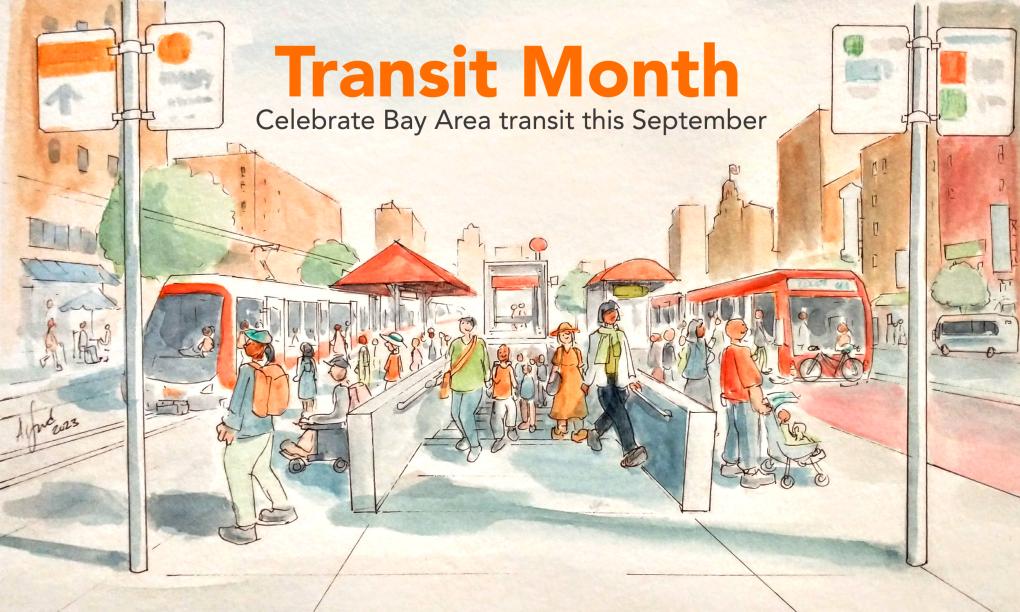
Friday, Sept. 22 – There’s lots do this weekend by way of BART, and we’re here to tell you all about it. Can you believe we're already at the end of September?
Before we get to this weekend's events, we have some exciting news to share. Last weekend, we challenged the region to break the Saturday September 2022 ridership record of 500,000+ trips across all local transit agencies. We are thrilled to announce...we beat the record! On Saturday, Sept. 16, the Bay Area took a stupendous 600,000+ trips. Let's keep the momentum going.
There are lots more Transit Month events on the horizon for the last week of September. On Friday, Sept. 29, join BART’s General Manager Bob Powers along with eight other regional transit leaders for a ride-along and social event. All Aboard with Transit CEOs begins at 5pm at the Palo Alto Caltrain Station/Transit Center. You don’t want to miss it! More info here.
Bus bridge alert: This Saturday and Sunday, Sept. 23 and Sept. 24, there will be hazardous tree removal and track work between Union City and Fremont stations. To provide workers with enough room to safely do the work, free buses will replace trains between Union City and Fremont stations. Riders in the area should anticipate delays of up to 30 minutes. There will be no Green Line service this weekend, meaning trains will not come as frequently as usual and transbay riders will need to transfer. Learn more about the bus bridge here and plan your trip using BART’s Trip Planner.
Now keep reading to hear what’s happening this weekend....
For an in-depth listing of local events, visit the BARTable website. We publish a weekly event roundup, BARTable This Weekend, that highlights happenings around the region as well as cool contests and sweepstakes from our partners.
Friday, Saturday, and Sunday, Sept. 23, 24, 25: Oakland Athletics play the Detroit Tigers at Oakland Coliseum
Baseball season continues with three home games at Oakland Coliseum as the A’s face the Tigers. The Friday game (6:40pm start time) includes an Esteury Ruiz t-shirt giveaway; Saturday (1:07pm) is an MLB Network hat giveaway; and Sunday (1:07pm) is Kids Cheer Free, meaning A's fans ages 14 and under can root for the Green and Gold for free (For each regularly priced ticket purchase, adults can add up to two additional free tickets.)
BART is the best way to get to the game. Read our guide on BARTable.
Saturday and Sunday, Sept. 23 and Sept. 24: 26th Annual Lafayette Art and Wine Festival
This weekend, one of Contra Costa County’s largest festivals takes over downtown Lafayette for a weekend of food, wine, beer, art, and music. The 26th Annual Lafayette Art and Wine Festival runs from 10am to 7pm on Saturday and 10am to 6pm on Sunday. Admission and parking are free, and BART is just a short walk from the fest.
Keep your eyes out for the BART booth, where staff will be on-hand to answer questions and hand out merch.
One Book One BART: BART launches fall ‘23 book club with acclaimed novel by Oakland-based author
On Monday, Sept. 18, BART announced the start of the One Book One BART Fall ‘23 Book Club. The novel strategy for rider and employee engagement follows on the heels of our first book club, which debuted last Spring with Hua Hsu’s Pulitzer-winning Stay True.
This fall – from September 18 to early November – we’ll be reading On the Rooftop (Ecco) by Oakland-based author Margaret Wilkerson Sexton. On the Rooftop is a novel about a mother whose dream of musical stardom for her three daughters collides with their own aspirations, set against a backdrop of a gentrifying 1950s Fillmore District in San Francisco.
We’ve programmed a series of events for employees and the public throughout the fall, including an author talk at our headquarters in Oakland early November and a Train Read-In (think roving book club-style discussions + trivia on a moving train) in October. We hope to see you there!
Stay up to date with events and sign up for the mailing list at bart.gov/bookclub.
Go Shopping, Take BART: Check out vintage and consignment shops near BART stations
There are many hip vintage and consignment shops near our stations. Get on BART and update your autumn wardrobe without having to spend a pretty penny.
Check out BARTable’s roundup of some of our favorite vintage and consignment shops here.
Happy Riding this Weekend!
We hope you enjoy your weekend adventures aboard our trains.
Stay in touch by signing up for the BARTable This Weekend newsletter on the BARTable website – your one-stop shop for all things accessible by BART. You can also keep up with BARTable on Facebook and Instagram.
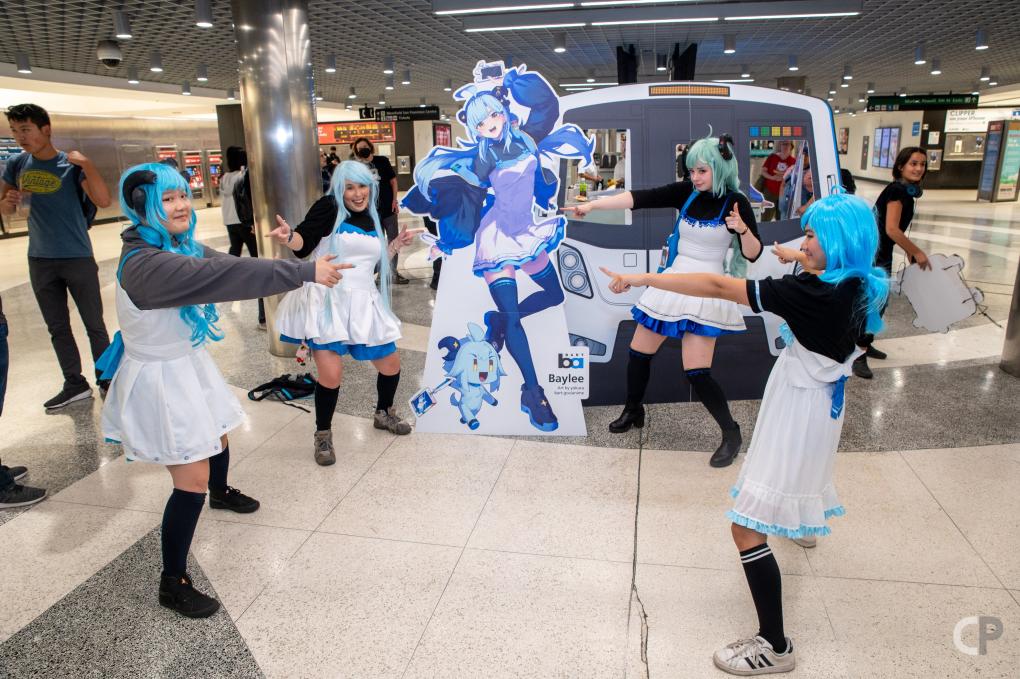
Cosplayers dressed up as BART mascot Baylee pose for a photo during BART’s Meet the BART Anime Mascots event on Saturday, Sept. 16 at Powell St. Station. Photo courtesy of CP Productions.
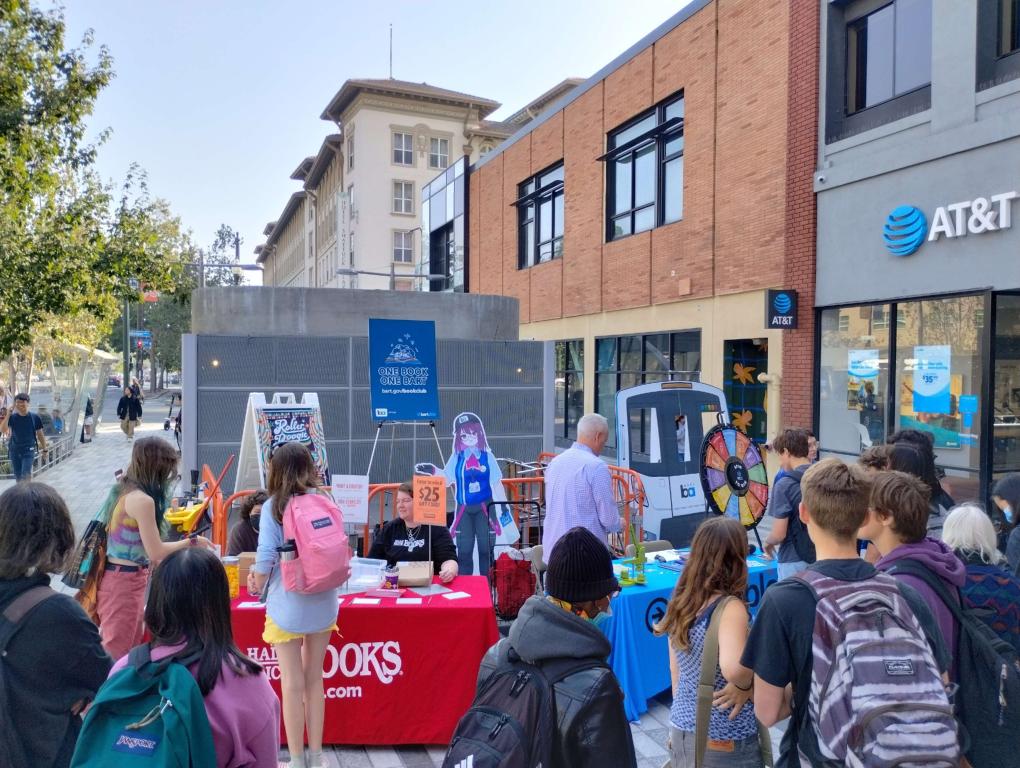
Riders spin the prize wheel, make buttons, and play games with Half Price Books at the One Book One BART Fall ‘23 Book Club kickoff event on Wednesday, Sept. 20, at Downtown Berkeley BART Plaza.
BART Holiday Merch available for preorder or purchase at Railgoods popup shops + SweaterFest

UPDATE: BART Holiday Merch is so popular, we have sold out of our current inventory.
Fear not: You can still purchase all BART holiday merch -- sweaters, vests, beanies, and scarves -- at an upcoming Railgoods holiday popup shop at select BART stations, which will have limited inventory on hand (see dates and locations below). You also have the option to preorder holiday merch on Railgoods.com here (more info below).
Railgoods Holiday Popups:
Wednesday, Nov. 6, 3pm to 6pm, Daly City Station
Wednesday, Nov. 13, 3pm to 6pm, Pleasant Hill Station
Wednesday, Nov. 20, 3pm to 6pm, El Cerrito del Norte Station
Saturday, Dec. 7, 1pm to 4pm, Sweaterfest at Rockridge Station
Thursday, Dec. 12, 3pm to 6pm, Dublin/Pleasanton Station
If you preorder your items on Railgoods.com, at checkout you will have the option to:
Pick up your order at SweaterFest on Saturday, Dec. 7, 1pm-4pm, at Rockridge Station. More info below.
Ship your order for a fee. Items will begin shipping the week of December 9.
Pick up your sweater at BART's Customer Services Center at Lake Merritt Station (hours: M-F 8:30am to 4:45pm). If you select this option, you will receive an email when your order is ready. Orders should be available for pickup the week of December 9.
SweaterFest is back!
Mark your calendars for Saturday, Dec 7, 1pm to 4pm, at Rockridge Station (College Ave. @ Keith). Wear your BART holiday sweater from any year and enjoy crafts, cookies, music, and more. 2024 BART holiday merch will be on sale at the event. There will also be a booth to pickup preordered holiday merch.
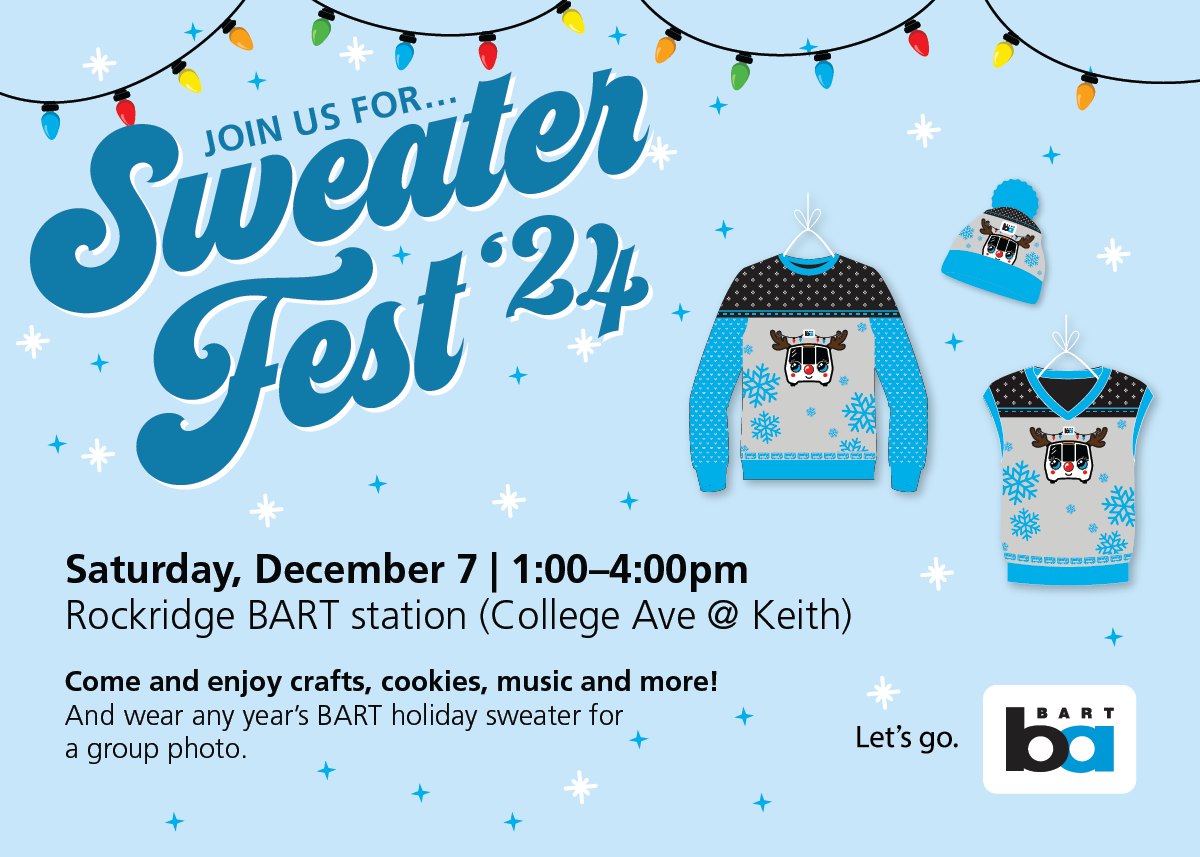
If you preordered a sweater this summer...
If you preordered your holiday merch this summer, your order will arrive shortly. Those who selected the in-store pickup option during the presale should keep an eye out for an alert that their order is ready for pickup.
You can also win holiday merch from BARTable! Sign up for the BARTable This Week newsletter on bart.gov/bartable to enter holiday sweepstakes and to hear about fun holiday events by BART stations.
2024 BART Holiday Merch Prices
Shipping costs vary by weight and location.
Sweater - $49.99 (limit to 2 sweaters per order)
Vest - $39.99
Beanie - $15.99
Scarf - $19.99
BART is at the heart of the Bay Area, and we should be proud of the public institutions that make our region merry and bright. Buy some merch and rep your love for BART and the Bay – the ugly sweater way.
This is the fourth year BART has sold holiday sweaters. Last year, we sold our entire inventory of 3,000 sweaters. Sales exceeded $100,000.
BART is one of the first transit agencies to sell holiday sweaters. We designed the first sweater in 2021 as a BARTable contest giveaway and ordered just five for the contests. Our inventory proved insufficient after General Manager Bob Powers wore one of the sweaters during a media event about BART’s air filters. People wanted them...badly. A week later, we held a sale for the public, and the sweaters sold out in under an hour.
Every year since, despite increasing our inventory into the thousands, the sweaters have sold out.
BART invites small business owners to its 2024 Small Business Summit
BART is pleased to announce it will host its 2024 Small Business Summit event on Monday, April 29th, 2024 on the first floor of its headquarters located at 2150 Webster St. in Oakland.
Attendees will have the opportunity to hear tips from small business owners who have been awarded BART contracts, network with prime contractors, hear about upcoming contracts, learn about BART’s equity program and certifications process and learn about resources available to small businesses from community partners and other regional transit agencies.
BART is committed to ensuring that small businesses are afforded equal opportunities to participate on District contracts and agreements. Small businesses include Disadvantaged Business Enterprises, Disadvantage Veteran Business Enterprises, Minority-Owned Business Enterprises, Women-Owned Business Enterprises and Micro Small Business Entities.
Representatives from several departments and groups at BART will be available at the event to answer questions about upcoming contracts, programs and resources for small businesses. These include representatives from BART’s Infrastructure Delivery and Procurement departments along with staff from BART’s Office of Civil Rights and Small Business Support Services. April 29-May 3 is National Small Business Week. Visit bart.gov/ocr for a list of scheduled events during the week.
Registration is preferred for BART’s 2024 Small Business Summit. Here are event details:
Date: Monday, April 29, 2024
Location: 2150 Webster Street, Oakland CA 94612 (1st floor)
Time: 12:30-3:30 PM
Here is the event schedule:
- 12:30 -1:00 PM: Registration
- 1:00 - 1:30 PM: Opening Remarks
- 1:30 - 2:00 PM: Small Business Success Stories Panel
- 2:00 - 3:30 PM: Networking between BART Staff, Primes, Small Businesses and Public Transit Agencies
Please register at the link here!

BART’s popular restroom attendant program expands to El Cerrito del Norte
BART’s busy and recently modernized El Cerrito del Norte Station now has a restroom attendant to greet riders and ensure restrooms remain clean, safe, and accessible to riders. This recent expansion to El Cerrito del Norte has been accomplished without an additional cost to BART’s budget because BART is using existing staff resources, utilizing employees on a temporary modified assignment.
This is the first time BART is deploying an attendant to an above ground station and the first time BART is using existing BART staff and not a contractor. Previously only underground station restrooms that have been recently reopened to the public included attendants staffed by contracted workers from District Works.
Seven BART stations now have restroom attendants during all operating hours including Embarcadero, Montgomery, Powell, Lake Merritt, 19th Street Oakland, Downtown Berkeley, and now El Cerrito del Norte. Attendants greet riders, record bathroom usage, check on cleanliness, notify janitors when they are needed, and intervene, if necessary, by calling BART Police.
When the El Cerrito del Norte Station was modernized, the restrooms were rebuilt with a more open concept with partitions inside and no main door at the entryway. This design, along with the addition of an attendant, has reduced lines to use the restroom. Station Agents can now focus on other customer service assistance instead of needing to check on the restrooms and handle issues related to restrooms being abused.
BART Director Rebecca Saltzman requested the addition of attendants at El Cerrito del Norte station, “Restroom attendants have proven to discourage unwanted behavior inside restrooms, ensuring they remain open, clean and safe,” said Saltzman. “Since we’ve added an attendant at El Cerrito del Norte, I have personally noticed an improved experience for riders using the restrooms. I want to thank BART leadership for testing this new approach of using existing staff resources to add an attendant to the restroom.”




